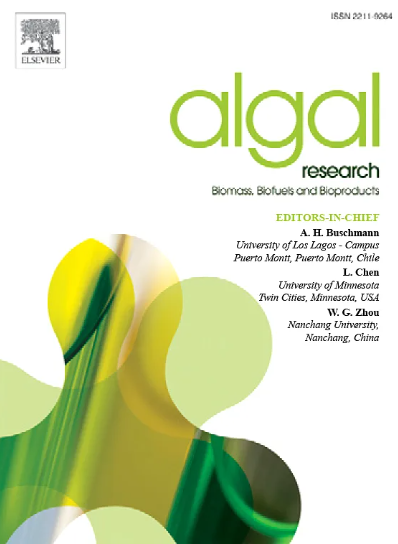通过固定在聚乳酸纳米纤维中保存微藻细胞的创新技术
IF 4.5
2区 生物学
Q1 BIOTECHNOLOGY & APPLIED MICROBIOLOGY
Algal Research-Biomass Biofuels and Bioproducts
Pub Date : 2024-11-02
DOI:10.1016/j.algal.2024.103781
引用次数: 0
摘要
微藻具有重要的生物技术价值。因此,在任何时候都必须采用维护方法来利用微藻。促进微藻在纳米纤维上的吸附过程可能是一种很有前景的微藻保存方法。因此,本研究的目的是将聚(乳酸)纳米纤维用于保存微藻小球藻 LEB 111 细胞。研究人员对纳米纤维的形态、热性能、结构特征和润湿性进行了表征。微藻细胞被固定在纳米纤维上,并在室温、冷藏和恒温室中保存 30 天。游离微藻细胞也在传统微藻保存方法(连续复制)的相同条件下保存了相同的时间。用中性红(NR)和胰蓝(TB)分析了纳米纤维上游离和固定细胞的活力。实验结束时,固定化细胞的存活率(94% 和 100%)高于游离细胞(84%)。在评估的储存条件下(冷藏、室温和恒温室分别为 3.6、3.6 和 2.8 g L-1),固定化细胞的培养在培养的第 25 天显示出显著的细胞生长。因此,聚乳酸纳米纤维(PLA)被认为是一种创新的微藻养护技术。本文章由计算机程序翻译,如有差异,请以英文原文为准。
Innovative technology for microalgal cell preservation through immobilization in polylactic acid nanofibers
Microalgae are of great biotechnological importance. Thus, it is essential to apply maintenance methods for the utilization of microalgae at any time. Facilitating microalgae adsorption processes on nanofibers may be a promising approach for microalgae preservation. Thus, the objective of this study was to apply poly (lactic acid) nanofibers in the preservation of microalgae Chlorella fusca LEB 111 cells. The nanofibers were characterized regarding their morphology, thermal properties, structural characteristics and wettability. The microalgae cells were immobilized on the nanofibers and stored for 30 days at room temperature, refrigeration and thermostated chamber. Free microalgae cells were also maintained for the same period under the same conditions of the traditional method of microalgae preservation, continuous replication. The cell viability of the free and immobilized cells on the nanofibers was analyzed by Neutral Red (NR) and Trypan Blue (TB). At the end of the experiment, the immobilized cells showed greater viability (94 and 100 %) compared to the free cells (84 %). The cultivation of immobilized cells showed significant cell growth on the 25th day of cultivation for the evaluated storage conditions (3.6, 3.6 and 2.8 g L−1 for refrigeration, room temperature and thermostatted chamber, respectively). Therefore, poly (lactic acid) nanofibers (PLA) are characterized as an innovative technology for microalgae maintenance.
求助全文
通过发布文献求助,成功后即可免费获取论文全文。
去求助
来源期刊

Algal Research-Biomass Biofuels and Bioproducts
BIOTECHNOLOGY & APPLIED MICROBIOLOGY-
CiteScore
9.40
自引率
7.80%
发文量
332
期刊介绍:
Algal Research is an international phycology journal covering all areas of emerging technologies in algae biology, biomass production, cultivation, harvesting, extraction, bioproducts, biorefinery, engineering, and econometrics. Algae is defined to include cyanobacteria, microalgae, and protists and symbionts of interest in biotechnology. The journal publishes original research and reviews for the following scope: algal biology, including but not exclusive to: phylogeny, biodiversity, molecular traits, metabolic regulation, and genetic engineering, algal cultivation, e.g. phototrophic systems, heterotrophic systems, and mixotrophic systems, algal harvesting and extraction systems, biotechnology to convert algal biomass and components into biofuels and bioproducts, e.g., nutraceuticals, pharmaceuticals, animal feed, plastics, etc. algal products and their economic assessment
 求助内容:
求助内容: 应助结果提醒方式:
应助结果提醒方式:


